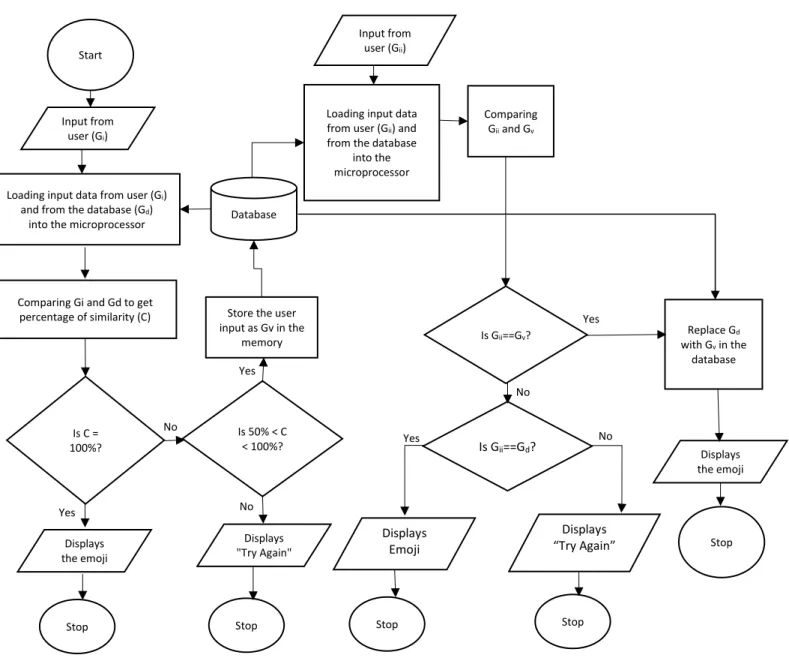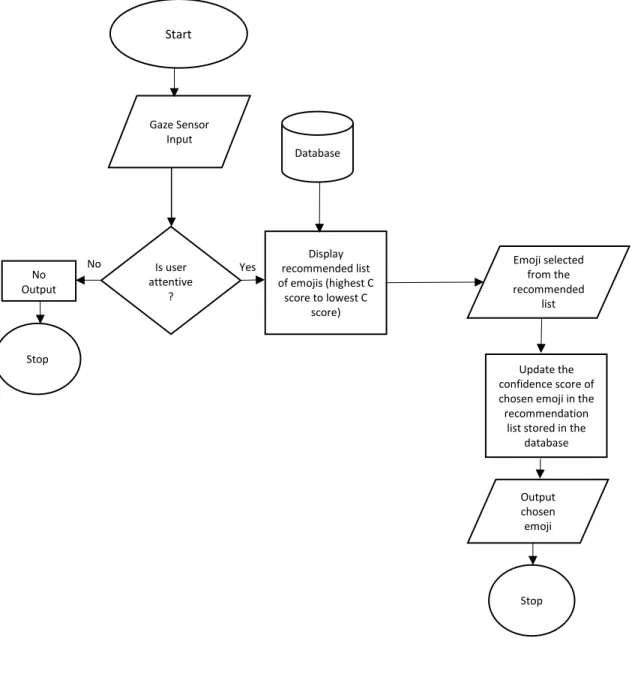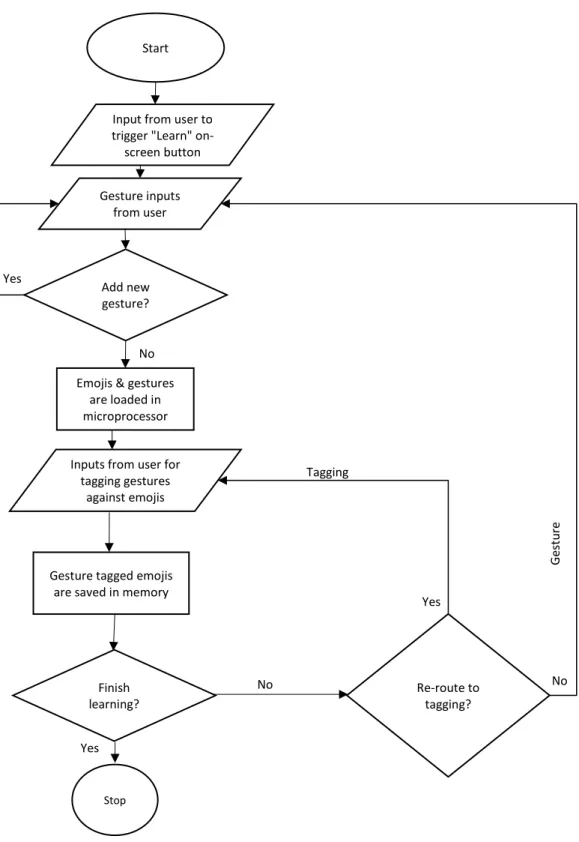December 10, 2018
Gesture Text Input
Anonymous AnonymousFollow this and additional works at:https://www.tdcommons.org/dpubs_series
This work is licensed under aCreative Commons Attribution 4.0 License.
This Article is brought to you for free and open access by Technical Disclosure Commons. It has been accepted for inclusion in Defensive Publications Series by an authorized administrator of Technical Disclosure Commons.
Recommended Citation
Anonymous, Anonymous, "Gesture Text Input", Technical Disclosure Commons, (December 10, 2018) https://www.tdcommons.org/dpubs_series/1768
Gesture Text Input
AbstractThe present publication describes a system that allows users to generate one or more emojis based on gesture inputs, while communicating using a computing device. The computing device may include a mobile phone, tablet, PC, or any other relevant computing device that can be used for communication. In one example, the communication takes place on an Instant Messaging (IM) application (app) running on a mobile device.
Introduction
IM services are predominantly used for text-based communications; however, at times such services fail to convey appropriate sentiments of a sender. Such failure can be attributed to lack of expressions linked with the texts. Emojis are icons/logos that are created to express a set of emotions such as happy, sad, angry, etc. They are also helpful during communications as they eliminate a need to show emotions using a set of words.
Emojis available for use today are quite high in number. Scrolling through a list of such emojis to select relevant one/s is substantially time-consuming. Researchers and companies have been trying to provide a list of keyboard shortcuts that can be used to input one or more emojis; however, the caveat is to remember or locate these shortcuts during communications. In addition, creating so many shortcuts results in a cumbersome task.
This disclosure provides a solution to the existing challenges (as mentioned above) by allowing users to input various emojis during conversations based on their gestures. Therefore, the user
is not required to scroll through a substantial list of emojis or remember keyboard shortcuts to
select the most appropriate/relevant one.
Description of the system
Figure 1 below illustrates components of the system as highlighted in this disclosure. The system includes:
• an image capturing module,
• a button that aids in activation/deactivation of the ‘gesture-based emoji generation’
feature,
• a microprocessor,
• a memory including set of emojis,
• a database including head/hand gestures, and
• a display unit to present output (i.e. emoji(s)).
The system can reside in a smartphone, computer, laptop, tablet.
Figure 1 - Components of the disclosed system.
The button for activating/deactivating gesture-based emoji generation can be made available as a feature in the IM app/service or can be embedded as a virtual button in an on-screen keyboard of the computing device. In addition, a keyboard shortcut for computer/laptop devices can be defined by the user to save time to select/deselect the emoji generation feature.
The image capturing module includes a camera that captures a gesture of the user. In one example, the image capturing module includes a front camera embedded in a mobile device that captures the hand or head gesture/s made by the user during a communication session. Based on the detection of the hand or head gesture/s, an input is generated, which when processed by
the microprocessor generates an emoji that best defines the captured gesture/s. While processing the input (i.e. user gesture/s), the microprocessor compares the captured gesture with the hand/head gestures pre-stored in the database to identify the type of gesture inputted by the user. Once the microprocessor matches the input gesture to a gesture pre-stored in the database, a matching emojis stored in the memory is generated as an output. The output is displayed on the display screen of the system (e.g., smartphone, computer, laptop, tablet). The gaze sensor is employed to avoid reporting of any unintended gestures. To accomplish this, the gaze sensor detects attentiveness of the user towards the computing device or the image capturing module. For instance, if a person is waving in a direction away from the computing device, the gaze sensor does not allow the image capturing module to take that wave gesture as an input. This eventually avoids generation of any unintended gesture-based emojis during the communication sessions.
Primary working embodiment of the disclosed system
Once the user selects the button to activate the ‘gesture-based emoji generation’ feature, the
image capturing module starts tracking the user’s head/hand gestures. Simultaneously, the gaze
sensor records user focus or attentiveness by tracking the user’s eye/head movement. That
means, the system will only take a gesture as an input if the user gazes towards the computing device while making that gesture.
There is a pre-defined set of emojis stored in the memory such that each emoji is correlated to a unique set of gestures. Similarly, there is a database of pre-recorded gestures. When a gesture is taken as an input, the microprocessor compares the input with the gestures already stored in the database. Based on the comparison, the microprocessor outputs in binary, that is, if the input matches with a gesture stored in the database, the microprocessor correlates the identified input
with the list of emojis corresponding to the matched gesture to display a matching emoji as an
output. In contrast, if the input does not match with a stored gesture, the microprocessor triggers a message “Try Again” to the user, as shown in Figure 2.
Figure 2 – The primary working embodiment of the disclosed system
Extended embodiments of the disclosed system
Second working embodiment (Emoji personalization) - Every individual has a unique way of
expression; therefore, people express a same gesture in their own unique ways. In one embodiment (shown in Figure 3 below), the disclosed system incorporates a computer vision
system, a set of analytical programs, which determines a percentage difference in a user’s
gesture and the recorded gestures in the database. In case a new gesture is close to a
pre-Start
Input (Gi)
Loading input data (Gi)
from user and from database (Gd) into micro-processor Comparing Gi and Gd Is Gi==Gd? Is user attentive? Database No Yes No Yes Display “Try Again” Display Emoji Stop Stop
recorded gesture and is inputted multiple times, the system checks the correlation and automatically adds the new gesture to the matched set of pre-recorded gestures.
Figure 3 - The second working embodiment of the disclosed system
Once the gaze sensor detects user attentiveness, the system triggers a command of capturing the user’s gestures. As a result, the analytical programs detect the gesture of the user. The
detected gesture (Gi) is first compared to the gestures (Gd) already stored in the database and a
percentage value of comparison (C) is calculated. If the detected gesture (Gi) matches as the
Start
Input from user (Gi)
Input from user (Gii)
Comparing Gi and Gd to get percentage of similarity (C)
Replace Gd
with Gv in the
database Loading input data from user (Gi)
and from the database (Gd)
into the microprocessor
Loading input data from user (Gii) and
from the database into the microprocessor
Store the user input as Gv in the memory Comparing Gii and Gv Is 50% < C < 100%? Is Gii==Gv? Is C = 100%? Database Yes Stop Stop Displays the emoji Displays the emoji Displays "Try Again" Yes Yes No No Displays “Try Again” Displays Emoji Is Gii==Gd? Yes No
Stop Stop Stop
stored gesture (Gd), the microprocessor will output an emoji, which is tagged with the stored
gesture (Gd). If there is no match, the microprocessor will check similarity between the two
gestures (Gd and Gi) and basis the similarity, separate decisions are taken. In one example, if C
lies between 50 and 100, the system will tag this C value to a new gesture (Gv) in the database
and asks the user to try entering the gesture again. If the second input gesture (Gii) is equal to Gv,
the gesture Gv is stored in the database and a most appropriate emoji is generated for this new
gesture Gv.
Every time the user provides a gesture that is not already stored in the database, the system finds
an emoji that is most appropriate to this new gesture and adds the gesture (Gv) in the
corresponding set of gestures for the matching emoji, based on the C value and the number of times the new gesture is inputted. Therefore, the system is adaptive in nature and includes self-learning mechanisms to adapt new gestures.
Third working embodiment (Recommendation) - There are many gestures, which are almost similar, or which could have different meanings for users from different cultural backgrounds. Therefore, it is culturally subtle to provide a user with options of different emojis, which although are distinct but convey the same emotion or expression that the user wants to express.
In this implementation, a set of emojis are stored against each gesture and are presented to the user. As soon as the user selects an emoji from the presented set of emojis, the selection is stored
in the memory as instructions to learn from the user’s choice and form a recommendation list of
emojis. In addition, the system assigns certain confidence values to each emoji in a given set. Typically, the emoji that has been selected by the user in the past for a given input gesture scores a higher confidence value than an emoji that has never been selected by the user.
Upon receiving a repeat gesture as an input, the system will display a recommendation list consisting of emojis tagged with the detected gesture. The emojis are displayed in descending
order of confidence values. Based on the user’s selection of emoji, the confidence values of the
recommended emojis are updated. This way, the system learns from the user choices and
Figure 4 - The third working embodiment of the disclosed system
Fourth working embodiment (User-defined Emojis)– In this embodiment, the system allows the
user to tag emojis as per preferences. On the app, there can be an on-screen button “Learn”,
which when selected by the user, allows the user to input and tag gestures. The entered gestures can be stored in the database. After the gestures are detected and stored, the user is provided
with the list of the emojis from which the user can tag the emojis against the user’s stored
gesture. After the tagging is complete, the system provides the user with options to either revert
to input gestures (to add new gestures) or tag the emojis (to tag more emojis). The user can stop the
process as shown in Figure 5.
Update the confidence score of chosen emoji in the recommendation
list stored in the database No Output Display recommended list of emojis (highest C score to lowest C score) Is user attentive ? Emoji selected from the recommended list Database No Yes Stop Stop Output chosen emoji Gaze Sensor Input
Figure 5 - The fourth working embodiment of the disclosed system
Start
Inputs from user for tagging gestures
against emojis
Input from user to trigger "Learn"
on-screen button Gesture inputs from user Re-route to tagging? Add new gesture? Finish learning? Emojis & gestures
are loaded in microprocessor Yes No No Yes Tagging G es tu re In p u ts Stop
Gesture tagged emojis are saved in memory
Yes
Advantages
Currently, the most common method of showcasing one’s expression during textual conversation
is with the use of emojis, which are being offered by different apps and software. A user needs to scroll through a substantial list of emojis to find the most suitable emoji. This make the process slow, less efficient, and complex when implemented.
With the disclosed invention, a user can select the emoji, which is automatically generated from
his/her head or hand’s gesture/s making the process quite easily operable and reliable enough
to be implemented on all computing devices. Moreover, the present disclosure also provides a
recommendation list as per the user’s gesture/s, which improves every time because of the




